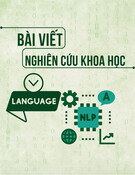
Tuyển tập Hội nghị Khoa học thường niên năm 2024. ISBN: 978-604-82-8175-5
568
REVIEW ON TEACHING GRAMMAR USING FOCUS ON
FORM FOR SPEAKING SKILL
Le Thu Ha
Thuyloi University, email: haleautumn@tlu.edu.vn
1. INTRODUCTION
Unlike the English language learning in the
past, the revolution of a variety of English
learning apps has changed the way individuals
acquire language skills. These applications
have offered a great variety of interactive
features such as gamified lessons and
personalized learning path, which can satisfy
almost all of learning styles at any time
anywhere. Fan (2023) and his colleagues
assert that because most of the apps focus on
“vocabulary learning enhancement” (p.4),
learners can improve their vocabulary
knowledge. Besides, Wang and Han (2021)
discover that apps have positive influence on
individual speaking performance.
Additionally, due to the advancement of
technology, language barriers seem to break,
espcially in speaking and listening because
learners can easily practise speaking through
different sources such as video calls or
language exchange platforms for a reasonable
cost or even free of charge. When learners
participate in communicative task like
“making an airline reservation”, “borrowing
books from library” or “finding street
destination”, form has become less important
than meaning and learners can achieve their
realistic purposes of second language
learning (Nunan, 2012).
Since the Communicative Language
Teaching Approach was introduced, its goal
has been intended to attain communicative
competence (Rodgers, 1986). Therfore, this
approach has been widely applied in teaching
English. Harmer (2001) also points out that
Communicative Language Teaching Approach
emphasizes the meaning instead of the
linguistic form. That is the reason why when
L2 learners are given ample opportunities,
their fluency is believed to be improved
despite learners’ language competence.
This questions teachers and educators as
well as second language (L2) learners
whether in this era, grammatical rules and
actual words of language are considered as
core materials for conversation (Sikorski,
2017) and what grammar can make
contribution to English speaking skill.
2. LITERATURE REVIEW
In fact, Hammerly (1991) explains that
grammar still plays an important role in
improving L2 learners’ accuracy so the
necessity to learn grammar is inevitable. In
addition, learning grammar has also offered
significant advantages. First, according to
Hinkel and Fotos (2002) , L2 learners who
study grammar can self-correct their current
speeach and use structures in communication
automatically. Additionally, Celce-Muricia
and Hills (1998) suggest grammartical
competence prove to be a good solution to
fossilization. This is understood as “a broken,
ungrammatical, and pidginized form of a
language” (p.2). Last but not least, for some
people, grammar may remind them of the
rules which are regid and inflexible.
However, Littelwood (1981) asserts that not
only can L2 learners give the right answers to
fixed patterns or structures, they can also
learn grammar in the very creative way. In
other words, they “make choices within the
grammatical system itself” (p.172).

Tuyển tập Hội nghị Khoa học thường niên năm 2024. ISBN: 978-604-82-8175-5
569
Although some scholars have defined the
term of grammar, Celce-Murcia and Larsen-
Freeman (1998) seem to give the most
general view that “grammar is not merely a
collection of forms but rather involves the
three dimensions of what linguists refer to as
syntax, semantics, and pragmatics” (p.4).
Accordingly, learners learn not only “a
system of rules” (Brown, 1997, p.347) but
also “the structure, the rule and usage of the
form in communication” (Yu, 2013, p.13).
As Lightbrown and Spada (1993) and Ellis
(1997) suggest that when communication be
taken into consideration, grammar be the
central focus. In addition, and Brown (1997)
shares the same idea that the integration of
grammar into meaningful and communicative
context is advisable. Thus, the study was
guided by the following questions:
1. What curent approach is the best for
teaching grammar so that it can help L2
learners develop their accuracy?
2. What advantages and disadvantages of
this approach are in the TLU language
learning setting?
3. METHODOLOGY
This study is secondary research in which
secondary data including books and research
papers is employed with a view to evaluating
the importance of grammar in teaching and
learning speaking skill. Furthermore, the
study aims to identify the best approach to
help students learn and use grammar in
communication effectively and creatively.
4. RESULTS
4.1. Research question 1
PPP model was first introduced by Byrne
and gained great popularity in the 1980s
(Willis, 2012). Nontheless, some scholars
have pointed out some drawbacks. Izumi
(2012), Sato (2012) and Skehan (1996) all
agree that PPP does not work effectively in
teaching grammar and communication.
Therefore, some other approaches emerged
so that L2 learners are able to improve
accuracy in communication. These include
Focus on Forms, Focus on Meaning and
Focus on Form. Of these three methods,
Focus on Form is the approach which takes
advantage of the strength of traditional Focus
on Forms and Focus on Meaning. This
approach first introduced by Long and then
Ellis (2016) states that the term then has been
employed and extended by a great number of
scholars and researchers. Particularly, Long
(1991) asserts that Focus on Form “overtly
draws students’ attention to linguistic
elements as they arise incidentally in lessons
whose overriding focus is on meaning or
communication” (p.45-46). In fact, Focus on
Form is taken into consideration in both two
sides by Long (1991) and other scholars such
as Doughty and William (1998). Long (1991)
believes that if L2 learners’ linguistic
problems occurring in their communication
are “repetitive” and “pervasive”, then Focus
on Form should be applied. (p.45-46). On the
other hand, Doughty and William (1998)
suggest that Focus on Form be the best
choice to assist L2 learners to improve their
accuracy in oral activities because teachers
will anticipate potential language difficulties
in order to create or design suitable
pedagogical materials.
4.2. Research question 2
4.2.1. Advantages
Thuyloi University (TLU) students
including English-majored, non English-
majored and students from advanced
programme can improve their accuracy in
speaking. According to Lightbown (1983) and
Pica (1983), Focus on Form can positively
influence the long-term accuracy of linguistic
form, which is really beneficial to TLU
students. To her 17-year experience of teaching
TLU students speaking skill and grammar, a
large proportion of students in all the
researcher’s groups make many grammatical
errors in their utterances despite their correct

Tuyển tập Hội nghị Khoa học thường niên năm 2024. ISBN: 978-604-82-8175-5
570
grammar exercises or tests. Doughty and
Williams (1998) mention that if teachers
follow Focus on Form, they can help their
students correct their errors accurately. More
importanly, many scholars share the same
opion that the more focus-on-form techniques
are applied, the more accurate use of target
structures is achieved (Camhi & Ebsworth,
2008; Doughty & verela, 1998; Jourdenias,
Ota, Stauffer, Boyson, & Doughty 1995;
Loewen, 2005; Williams & Evans, 1998).
Besides, Poole (2012) claims that teacher’s
English proficiency is another key element in
enhancing learners’ accuracy. All TLU English
teachers prove themselves to be qualified as
they all have had TESOL certificates, some of
whom are Phd and some of whom are doing
their Phd courses. Apparently, they are able to
apply Focus on Form in order to enable TLU
students to achieve progress.
4.2.2. Disadvantages
Poole (2012) raises question of the
effectivenes of Focus on Form for big class
size. He argues that there is no evidence that
Focus on Form works effectively in
overcrowded classes. Meanwhile, non-major
English classes usually consist of 35-40
students.
5. CONCLUSION
A student who possesses a rich vocabulary
and grammar competence separately is not
able to communicate successfuly in terms of
meaning and linguistic accuracy. As Long
(1991) states, grammatical structures should
be used in a meaningful way to achieve
communication goals.
Apparently, Focus on Form with various
techniques has positive influence on students’
speaking skill when they have opportunities
to take part in communicative focus on form
activities. As a resutl, Ellis, Basturkmen and
Lowen (2001) assert that accuracy as well as
creativity of using new forms is improved.
inspite of its limitations.
In short, form-focused activities supported
by other suitable approaches, flexible
curriculum, qualified teachers and small
class size should be taken into consideration
in the context of learning and teaching
English at TLU.
6. REFERENCES
[1] Celce-Murcia, M. et al (1998). Techniques
and Resources in Teaching Grammar. New
York: Oxford University Press.
[2] Doughty, C. & Williams, J (1998). “Issues
and Terminology” Focus on Form in
Classroom Second Language Acquisition.
New York: Cambridge University Press.
[3] Harmmerly, H. (1991). Fluency and
Accuracy: Toward Balance in Language
Teaching and Learning. New York:
Multilingual Matters.
[4] Hinkel, E. & Fotos, S. (2002). “From
Theory to Practice: a Teacher’s View. New
Perspectives on Grammar Teaching in
Second Language Classrooms. New Jersey:
Lawrence Erlbaum Associates, 2002.
[5] Long, M (1991). “Focus on Form: A Design
Feature in Language Teaching
Methodology.” Foreign Language Research
in Cross-Cultural Rerspective. Ed. Kees de
Bot, Claire Kramsch and Ralph Ginsbeerg.
Amsterdam: John Benjamins. 39-52.

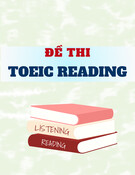

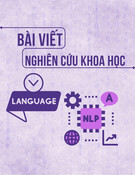


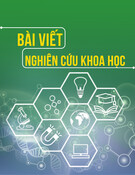
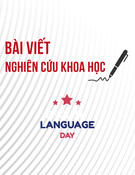

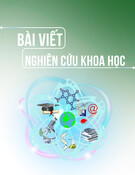

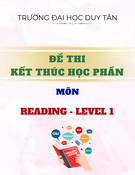
![Đề cương môn Tiếng Anh 1 [Chuẩn Nhất/Mới Nhất]](https://cdn.tailieu.vn/images/document/thumbnail/2025/20251130/cubabep141@gmail.com/135x160/51711764555685.jpg)


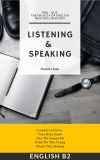





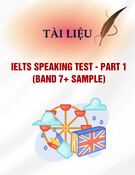

![Mẫu thư Tiếng Anh: Tài liệu [Mô tả chi tiết hơn về loại tài liệu hoặc mục đích sử dụng]](https://cdn.tailieu.vn/images/document/thumbnail/2025/20250814/vinhsannguyenphuc@gmail.com/135x160/71321755225259.jpg)
